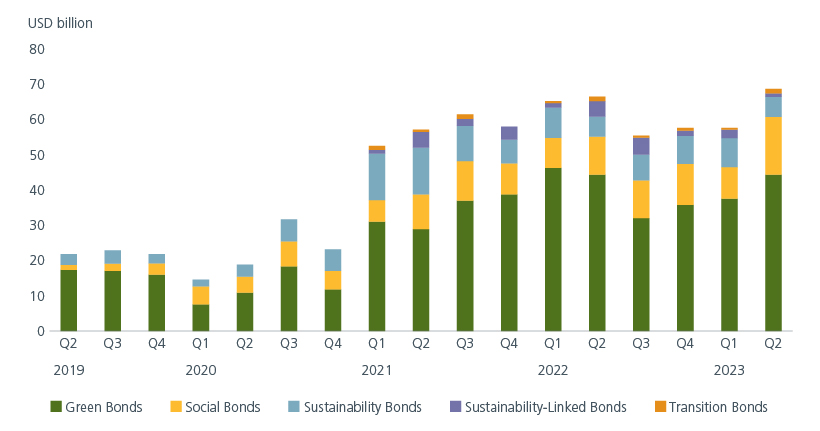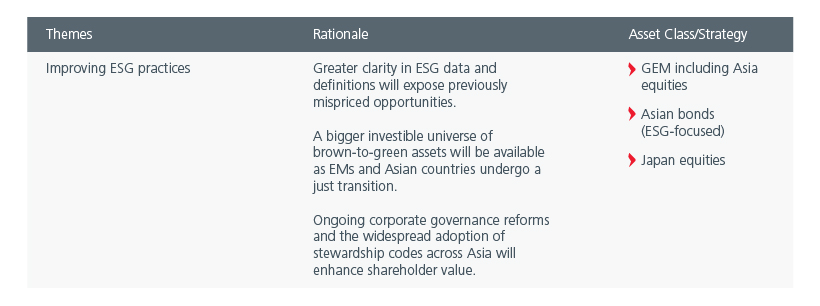Summary
The ESG investible universe is offering more differentiated opportunities, riding on the push for greater transparency and reliability in ESG data and definitions. Improved green and transition taxonomies will pave the way for more ESG offerings that meet investors’ climate objectives.
The Environmental, Social and Governance (ESG) landscape is moving away from definitions and products which address terms like ESG, Sustainability and/or Climate in a broad-brush manner. Progress is being made towards developing standards that serve as a basic guideline for sustainability-related data and disclosures. A better understanding of the risk and value drivers in the ESG context would lead to more realistic pricing of ESG assets, and in turn influence company valuations.
A constructive push for clearer ESG data and definitions
The ESG practice is trending towards greater distinguishment of exact ESG elements which can act as differentiators when assessing both impact and risk-adjusted returns. This is a welcome development for investors who can now look for investment opportunities in previously mispriced ESG assets. Less ambiguity implies that ESG risk and opportunity signals will be easier to identify both on a sector and market basis.
This encourages investors to develop their own ESG “house view” via proprietary analytical tools. Such tools allow investment teams to consider information which third party ESG ratings providers may not offer a uniform assessment of. It can include forward looking ESG data such as exposure to specific climate transition opportunities and/or significant actions taken by companies to develop climate solutions. Such an approach could result in an investible universe that differs from how climate transition is currently defined by the broader market.
Thus far, the market and regulatory focus has been on defining companies in terms of green assets or carbon emissions reduction. The disadvantage with this method is that it will sideline companies that are on a journey towards climate transition. With many developing countries still heavily dependent on fossil fuels, there is growing recognition that the transition to clean energy must be gradual as well as just.
Significant investment opportunity as Asia transitions to green
The move to define ESG elements in a clearer manner is consequential for Emerging Markets (EM) and Asia; many ‘brown’ or high-carbon emitting industries form a significant base of their gross domestic product. The International Energy Agency predicts that EMs will require significant public and private investments of around USD 2 trillion1 per year going forward to transition to clean energy through 2030, to achieve net-zero emissions by 2050.
The available opportunity set of pure green investments is more limited in Asia compared to developed markets. In the Asian investment universe, capturing a company’s progress in areas like energy efficiency, natural gas as a transition fuel, and using low-carbon materials is a crucial step in identifying early transition winners. Many companies in EMs and Asia were sold off as investors sought only pure green stocks, resulting in a big investible universe of attractively valued companies with good growth and return potential.
The regulatory landscape is also increasingly supportive for a just transition in Asia with regulators emphasising the need to develop sustainable taxonomies with a transition element. This can result in potential tailwinds for transitioning companies and assets. Investors and asset owners who help companies decarbonise in a practical and sensible manner can minimise negative social and environmental impact.
The ASEAN + 32 sustainable bond markets will play a key role in financing these transition assets. As of June 2023, this region maintained its 19.1% share of the global total outstanding sustainable bonds. Green bonds comprised 64%3 of the outstanding bonds and financing was done mostly in local currency. Although the flows to ESG-labelled funds were flat 2023 to date, it compares favourably against non-ESG labelled funds which experienced outflows. There is further potential to provide more long-term financing in local currency as the demand for ESG bonds from ESG-labelled funds remains strong.
ASEAN + 3 sustainable bond issuance is on the rebound

Source: : AsianBondsOnline calculations based on Bloomberg LP data. Data includes both local currency and foreign currency issues.
The move to greater ESG data clarity will also address some of the challenges facing the green bond market such as the lack of a common definition as to what constitutes a green project and the validation of the environmental and social outcomes of the projects. A comprehensive and inclusive approach is one that considers the interplay between the environmental, social, and economic objectives. This requires collaboration between various stakeholders such as issuers, investors, and regulators.
Reforms and regulations act as tailwinds
Regulations on ESG-labelled funds have toughened up considerably in 2023 as investors continue to regard ESG-focused investments as a way to mitigate ESG risks. The burden of proof is on funds to justify their ESG classifications and comply with reporting and disclosure requirements.
Meanwhile, oversight on ESG reporting and corporate governance practices are gradually improving across Asia. Singapore is proposing a code of conduct for ESG rating and data providers, South Korea is issuing guidelines on ESG ratings and greenwashing, Hong Kong is proposing enhanced ESG disclosures, and India has new rules for ESG investment funds.
Investors’ renewed interest in Japan equities this year is a testament of the positive impact of corporate governance. The Tokyo Stock Exchange’s Action Programme aligns with better corporate governance by promoting transparency, accountability, and adherence to established principles, hence contributing to a healthier market. The representation of independent directors on Japanese company boards is rising. More Japanese companies also now disclose and map ESG strategies to the Sustainable Development Goals compared to five years ago.
In general, Asian jurisdictions have widely adopted stewardship codes which facilitate and support engagement by institutional investors with their investee companies. Active engagement leads to optimal outcomes. Ultimately, regulations will remain as one of the key factors for driving change in ESG practices.
Investment implications

Contributors: Joanne Khew, Fabian Graimann, Goh Rong Ren
Related insights
The information and views expressed herein do not constitute an offer or solicitation to deal in shares of any securities or financial instruments and it is not intended for distribution or use by anyone or entity located in any jurisdiction where such distribution would be unlawful or prohibited. The information does not constitute investment advice or an offer to provide investment advisory or investment management service or the solicitation of an offer to provide investment advisory or investment management services in any jurisdiction in which an offer or solicitation would be unlawful under the securities laws of that jurisdiction.
Past performance and the predictions, projections, or forecasts on the economy, securities markets or the economic trends of the markets are not necessarily indicative of the future or likely performance of Eastspring Investments or any of the strategies managed by Eastspring Investments. An investment is subject to investment risks, including the possible loss of the principal amount invested. Where an investment is denominated in another currency, exchange rates may have an adverse effect on the value price or income of that investment. Furthermore, exposure to a single country market, specific portfolio composition or management techniques may potentially increase volatility.
Any securities mentioned are included for illustration purposes only. It should not be considered a recommendation to purchase or sell such securities. There is no assurance that any security discussed herein will remain in the portfolio at the time you receive this document or that security sold has not been repurchased.
The information provided herein is believed to be reliable at time of publication and based on matters as they exist as of the date of preparation of this report and not as of any future date. Eastspring Investments undertakes no (and disclaims any) obligation to update, modify or amend this document or to otherwise notify you in the event that any matter stated in the materials, or any opinion, projection, forecast or estimate set forth in the document, changes or subsequently becomes inaccurate. Eastspring Investments personnel may develop views and opinions that are not stated in the materials or that are contrary to the views and opinions stated in the materials at any time and from time to time as the result of a negative factor that comes to its attention in respect to an investment or for any other reason or for no reason. Eastspring Investments shall not and shall have no duty to notify you of any such views and opinions. This document is solely for information and does not have any regard to the specific investment objectives, financial or tax situation and the particular needs of any specific person who may receive this document.
Eastspring Investments Inc. (Eastspring US) primary activity is to provide certain marketing, sales servicing, and client support in the US on behalf of Eastspring Investment (Singapore) Limited (“Eastspring Singapore”). Eastspring Singapore is an affiliated investment management entity that is domiciled and registered under, among other regulatory bodies, the Monetary Authority of Singapore (MAS). Eastspring Singapore and Eastspring US are both registered with the US Securities and Exchange Commission as a registered investment adviser. Registration as an adviser does not imply a level of skill or training. Eastspring US seeks to identify and introduce to Eastspring Singapore potential institutional client prospects. Such prospects, once introduced, would contract directly with Eastspring Singapore for any investment management or advisory services. Additional information about Eastspring Singapore and Eastspring US is also is available on the SEC’s website at www.adviserinfo.sec. gov.
Certain information contained herein constitutes "forward-looking statements", which can be identified by the use of forward-looking terminology such as "may", "will", "should", "expect", "anticipate", "project", "estimate", "intend", "continue" or "believe" or the negatives thereof, other variations thereof or comparable terminology. Such information is based on expectations, estimates and projections (and assumptions underlying such information) and cannot be relied upon as a guarantee of future performance. Due to various risks and uncertainties, actual events or results, or the actual performance of any fund may differ materially from those reflected or contemplated in such forward-looking statements.
Eastspring Investments companies (excluding JV companies) are ultimately wholly-owned / indirect subsidiaries / associate of Prudential plc of the United Kingdom. Eastspring Investments companies (including JV’s) and Prudential plc are not affiliated in any manner with Prudential Financial, Inc., a company whose principal place of business is in the United States of America.








